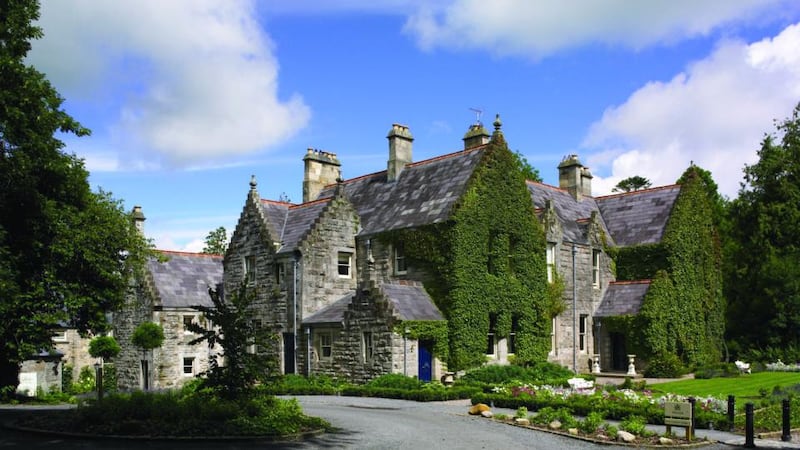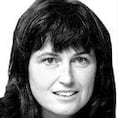The young horse is concentrating, trying to make sense of the lake when he is suddenly distracted by a bird that begins to tread nimbly along the surface. It leaves a trail of dancing white spray which so intrigues the horse that he too, high steps, knees up and immediately out-splashes the bird. Suddenly, out of the calm, a pike darts surprisingly close to us. There is water everywhere, in his mane, in my eyes and nothing matters, only the moment.
On cue, a heron glides across the sky. The lazy evening sun is casting yellow light causing the splendid Victorian house dominating the view to look even more special. But then Castle Leslie Estate in the undulating Co Monaghan landscape is unique, a grand mansion that has played its part in Irish social history and respects its own colourful past without being oppressed by it.
Messing about in boats is good, claimed the rat in The Wind in the Willows, and kayaking is another of the many outdoor activities on offer at Castle Leslie Estate as are hot air ballooning and falconry, but messing about on horses, in a lake, is even better.

There is a relaxed independence of spirit about the entire estate and it is very much at one with Glaslough village of which it is part. There is no “them and us”; the local community is proud of Castle Leslie Estate and the way it has survived through hard work and imagination and the family confidence of doing things the Leslie way.
There are many good stories about this working estate, one of which is recorded in A History of Gardening in Ireland and dates from 1866, about the time John Leslie had decided to build a new house on the lands where his family had first settled in 1664. Leslie had hired a Mr Broderick Thomas to clear the site. Mr Thomas, whose fee was five guineas a day, spent a week painstakingly placing visiting cards on the trees that were to be felled.
When Lord Powerscourt asked Leslie had he had the marked trees cut down, Col Leslie replied: “No sooner was Thomas off by train then I went around and took all the visiting cards off again.”
It seems typical of a family that believes in following instinct. Most of the surrounding trees survived and Leslie was certainly aware that a fine home needs a beautiful setting. Five years later, the wonderfully eccentric castle-like mansion designed by Sir Charles Lanyon and William Henry Lynn, was completed. It has a baronial feel about it and the grand entrance hall with its barrel-vaulted ceiling conveys a hint of the Middle Ages. There are also Italian decorative flourishes throughout, in the plasterwork, the fireplaces and the paintings. The drawing room is elegant yet lived-in as are the library and the billiard room, with its many portraits of horses and dogs, access to which is through the Long Gallery.
The Blue Room, as it has been called since 1907, should actually now be called the bird room as the walls have since been covered in individual hand-painted studies. There are 20 bedrooms in the main house, each with a personality of its own.
Currently in contention for eight awards, including Hotel and Catering Review Gold Medal award "Value for Money Hotel of the Year", Castle Leslie Estate has mastered the art of making meticulous attention to detail and quality service appear relaxed and natural; the staff is happy and welcoming. Guests are treated more like family friends. Dogs are welcome in the Old Stable Mews, and as this is one of the top 10 equestrian destinations in the world, so is your horse. There are an additional 29 bedrooms in the Lodge and 12 Old Stable Mews as well as the 11 village cottages in a square by the main gates.
It is living history, a big house world that has been part of Irish life over the centuries and, as is well known, young Winston Churchill often came to visit his aunt, Leonie Jerome, whose sister, Jenny, was married to Lord Randolph, the future leader’s father. During the Great Famine the widow of an earlier Leslie, Charles Powell II, (son of the Charles Powell Leslie who agreed to help educate Arthur Wellesley, the son of an impoverished brother-in-law, who grew up to become the Duke of Wellington), helped the local people.
Local employment was provided by having a 4½ mile-long wall built around the estate and soup kitchens were set up. Her son, Charles Powell III was openly eccentric and, with a passion for architecture, had some excellent ideas, including the building of the grain merchant store in the village and the lodges by the main gates.
On his death the estate passed on to his brother John, a painter of the pre-Raphaelite style, whose wife Constance, was seen strolling in the castle grounds on the day she died in London in 1925. There was a further sighting of her, 18 years later, at the deathbed of Leonie Churchill.
Various family members have been creative in other ways. Anita Leslie was a writer and war hero in her own right. Her Spitfire pilot brother, Desmond Leslie, father of the present owner, designed a multi-track sound mixing deck, while the design team of his second son Mark, creative director of Martello Media, devised the Yeats exhibition in the National Library.
The romance that was life in the big house is sustained by money and staff. As the world changed the fortunes of once great families changed.
Interestingly it was Samantha, the youngest child, and second daughter of Desmond Leslie’s second marriage, who became most involved in securing the estate’s survival. After a life of adventure, including five years as a prisoner of war in Germany, Jack Leslie, Sammy’s bachelor uncle, returned, and approaching 98, continues to hold court in his family home.
Samantha “Sammy” Leslie, born in 1966, began her project in 1991 by offering afternoon teas in the conservatory as a way of funding a new roof. In addition to a fine house, albeit one in need of repairs, she had a personal interest in horses as well as the 1,000 acres – including three lakes, one with a crannóg – that she, a qualified riding instructor, could utilise.
There had been a riding school which had operated independently in the grounds for about 20 years; she eventually purchased it back and today it has stabling for 56 horses, (28 of which belong to the equestrian centre), an indoor arena with viewing area, 300 cross country jumps, 21 miles of bridle ways, woodland trails and a mile-long, all-weather gallop. Group and private lessons are available for all levels of rider.
Castle Leslie Estate is very popular with American visitors and British who come specifically for the riding and also want a holiday based around it. A family group was preparing to head off on a trek and while the mother looked organised, wearing her well-worn old boots, a mild look of apprehension crossed the father’s face. As he pulled on a pair of gloves, his little daughter asked him if she could bring the pony home.
Just then a French woman who had mislaid her hat and was describing her horse, stopped in mid sentence on remembering where she had left it and hurried off.
Irish people come for the horse riding, many bringing their own horses for lessons and workshops, while large parties arrive in from the continent – and all for the horses. As expected, the Castle Leslie Estate stand at the recent Dublin Horse Show was busy all week. It took the entire array of their gorgeous brochures to satisfy the interest while, according to Michelle Maguire of Ireland's Blue Book: "I think it's fantastic to have an estate that offers so much with such an interesting history and family. The association with horses makes it so attractive when promoting Ireland abroad. I've noticed that the German market is very interested in activity holidays and horses in particular and Castle Leslie Estate does this so well."
Many a wedding guest returns for the cross-country course and the number of family parties returning is on the increase.
Horses do add to the beauty. Hunting prints, photographs of horses and equestrian motifs decorate the walls, a collection of bits are arranged near the entrance to Snaffles, the award-wining restaurant which is upstairs in a loft-like setting in the Lodge, which also includes a charming spa, the Victorian Treatment Room. The pleasure in the detail is often in the apparent simplicity of it, such as a row of children’s riding helmets, the velvet faded from use, now kept in a row along a ledge. Each of the bedrooms in the Lodge has been named after a horse that once lived and worked on the estate.
For the horse-minded, it is a paradise. I loved it. But for those who are not, there are many routes, of varying intensity, for walkers and for photographers – through the wetlands, near the old ice ponds where ice used to be cut for the castle. There is also a walled garden dating from the 1850s and about to be restored as a working garden. A herd of deer wanders about, while the rookery is home to about 25,000 rooks and starlings.
Nearby is Patrick Kavanagh country, as well as the ruins of the 13th-century Clogh Oughter Castle in neighbouring Cavan, and Florence Court and Castle Coole in Co Fermanagh and the Armagh Planetarium. Castle Leslie is self-contained within its grounds while also being part not just of Glaslough village and townland but of Ulster and the Border region.
It is difficult not to think of Sammy Leslie as a benign wizard happily plotting new wonders, but anything this good that looks so well and feels so relaxed must take enormous dedication and flair. It does. What began as a plan to rescue and restore a much-loved family home has become an ongoing international success story that showcases Ireland as well as local enterprise and one unusually tenacious daughter of the house.
Castle Leslie Estate: castleleslie.com


















